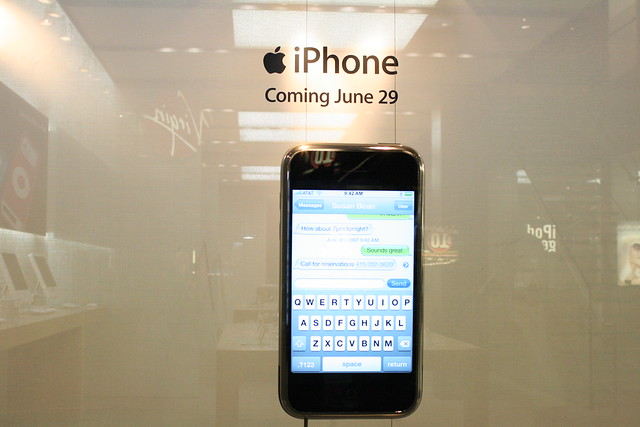It is with great joy that I inform you that the first iPhone was sold on June 29, 2007 in Palo Alto, California. A revolutionary device that has since brought about immense changes in the realm of telecommunications, captivating the world with its technological marvels.
Ah, my dear interlocutor, to my knowledge, Steve Jobs, the renowned co-founder of Apple Inc., did indeed frequent the Palo Alto Apple Store. The store, nestled in the heart of Silicon Valley where Apple’s headquarters reside, served as a hub for tech enthusiasts and industry giants alike. I imagine Mr. Jobs would occasionally visit this establishment, keeping a keen eye on the innovative products and interacting with the devoted Apple community.
Photos of suck event are held in this Flickr album by Brian Solis: https://www.flickr.com/photos/briansolis/sets/72157600554096598/
Key Features of the First iPhone
The original iPhone was groundbreaking for several reasons:
-
Touchscreen Interface: The iPhone was one of the first smartphones to feature a capacitive touchscreen, allowing users to interact with the device using their fingers instead of a stylus or physical buttons. This intuitive interface changed how users interacted with mobile devices.
-
Internet Connectivity: With built-in Wi-Fi and cellular data capabilities, the iPhone provided users with easy access to the internet, enabling browsing, email, and app usage on the go.
-
App Store: Although the App Store was launched a year later, the iPhone’s architecture was designed to support third-party applications, paving the way for a new ecosystem of mobile apps that would transform how people used their phones.
-
Multimedia Capabilities: The iPhone combined a phone, an iPod, and an internet communicator into one device, allowing users to listen to music, watch videos, and take photos—all from a single device.
Impact on Telecommunications and Technology
The introduction of the iPhone marked a paradigm shift in the telecommunications industry. It not only set new standards for smartphone design and functionality but also influenced the development of mobile applications and services. Competitors rushed to create their own smartphones, leading to a rapid evolution of mobile technology.
The iPhone’s success also contributed to the rise of mobile internet usage, changing how people communicate, work, and consume content. It laid the groundwork for future innovations, including the introduction of the App Store, which has since become a vital platform for developers and users alike.
In conclusion, the launch of the first iPhone was a watershed moment that reshaped the landscape of mobile technology and telecommunications. Its legacy continues to influence the design and functionality of smartphones today, making it a pivotal milestone in the history of technology.

